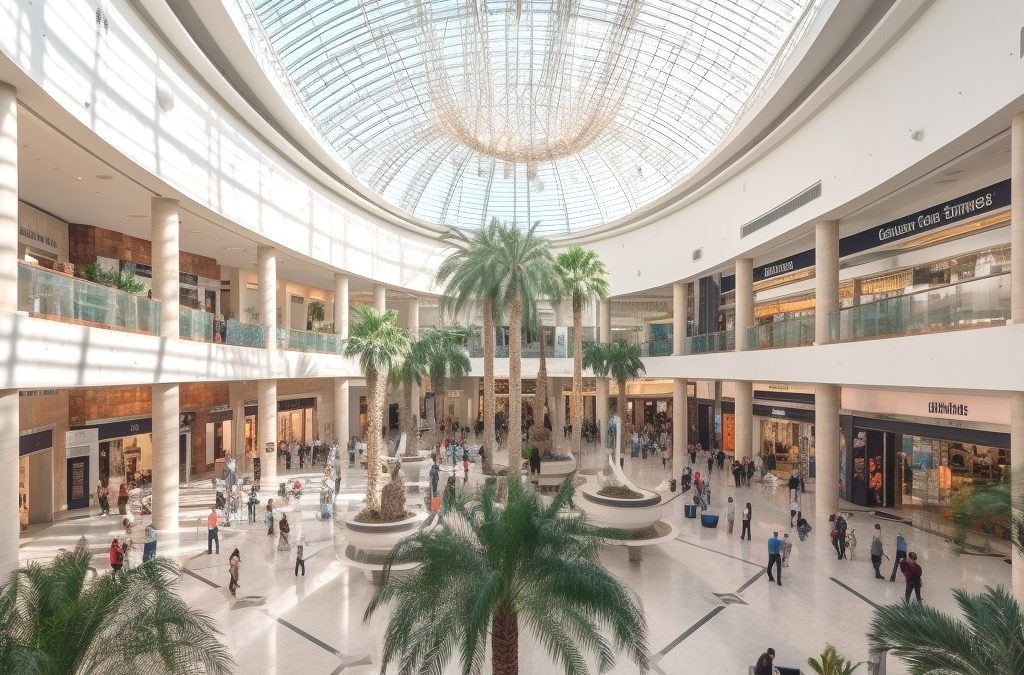The recent opening of Emporium Melbourne, a massive high-end shopping mall complex spanning 46,175 sqm of retail space, with an eye watering project cost of $1.6bn, brought a new generation of modern retail to Melbourne, Australia. The intertwined patchwork of buildings across multiple city blocks that makes up Emporium Melbourne is home to over 200 retail stores and restaurants.
This article reflects upon two journeys I’d made through the shopping mall. My maiden voyage through Emporium Melbourne took place in it’s first week soft launch opening to the public; the venue was completed but much of the stores were only represented as signage promising the brands that would eventually grace their floors. This represented an excellent opportunity to observe aspects of the mall itself without being dazzled by the sugar coated store content. The second journey, taking place later in the year, allowed me to walk the endless forest of fully occupied retail decadence for the complete immersive experience of the mall. The end result of these trips to a shopaholic’s crack den, left me with somewhat mixed feelings that I wish to share.

A Changing Landscape
On one hand, Emporium Melbourne represents a new calibre of inner city shopping, ushering in global retail brands previously inaccessible to Melbourne. It also brings an extensive list of flagship stores, representing new found product selection at a scale unfamiliar to Melbourne. On the other, it is that exact lack of global brand dominance in the city’s shopping experience, and a strong showing of unique one-off stores that gives Melbourne part of its charm and character. Ultimately, the city’s progress and gaining in world status, leads it to inevitably be indoctrinated into the realm of prestige and global brand shopping.
The Sugar Crash
Shimmering glossy metal, abundant glass and stone surfaces, slatted wood accented ceilings, thematic lighting; all part of an impressive feat that feels substantial and that you’ve arrived at a premium destination. Care has been taken in orchestrating a mall that clearly does target a discerning shopper of fine goods.
However, that initial euphoria of sensory stimulation quickly subsided and gave way to feelings of emptiness and underwhelmed longing. Why? Firstly, if I stood there, staring in any direction, I could have honestly been in any prestigious mall, in any global city, anywhere in the world. Was I in Singapore, Dubai, Jakarta, America? There were no uniquely Melbourne signatures. Were my expectations unrealistic? Really, it’s a mall.
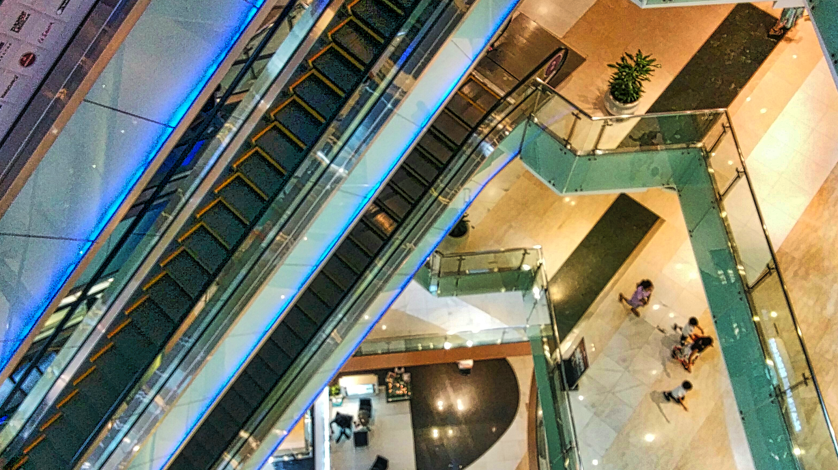
But malls are fighting for their existence all over the world. There’s millions, if not billions of square feet of abandoned or partially vacant malls globally. Should they not be reinventing and innovating to maintain or improve their relevance? Or are customers satiated by the time-tested and familiar mall experience they’d always had? Essentially rows of shops punctuated by food courts and escalators? As a user experience, Emporium offers little beyond what malls had in place in the 1970’s.
Food court options may be better dispersed across the floors, materials and attention to detail in the execution are vastly better. But it had little actual innovation, particularly considering it had come fresh off the mall assembly line in 2014. The floor by floor store maps are an utterly familiar trip through typical escalator configurations, retail floor plans and store arrangements. Everyone that’s huddled around map kiosks pointing at the screen have seen it all before, for decades. In fact the only hints of what you could consider elements of innovative user experience as opposed to ‘refined’ user experience, were in the form of hand lotion pumps and coffee. No kidding.
Call In The Coffee
A clothing store that occupied a corner end unit had ingeniously incorporated an espresso bar that wrapped around it’s corner edge, serving coffees to both in-store customers and the mall’s passer-by’s. To me, this was the one element that anchored me back to being in Melbourne. Through tying into one of the city’s key cultural icons, the cafe scene, I was back home again.
Its well executed manner, simplicity and of course fine drinking espresso, spoke to the Melbournian lifestyle. It also spoke to the “make use of every nook and cranny” mentality of the Melbourne CBD. Famous for it’s alleyway nondescript doorways leading to superb restaurant experiences, having a cafe made out of the corner of a store and in the way it had been constructed, felt right.
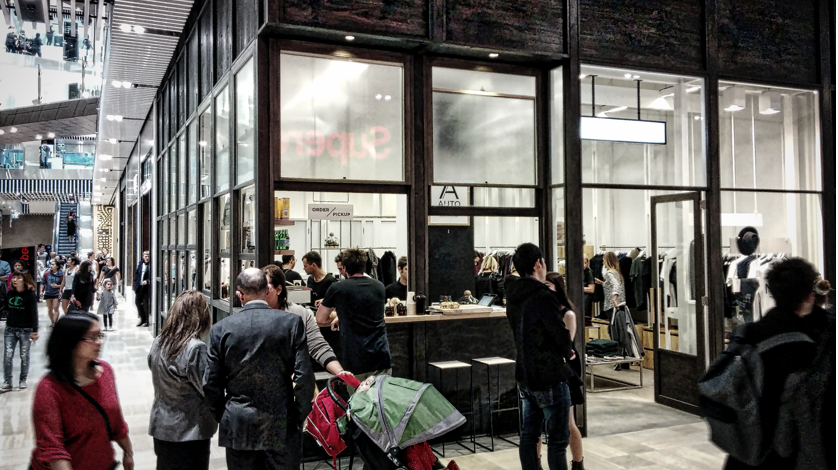
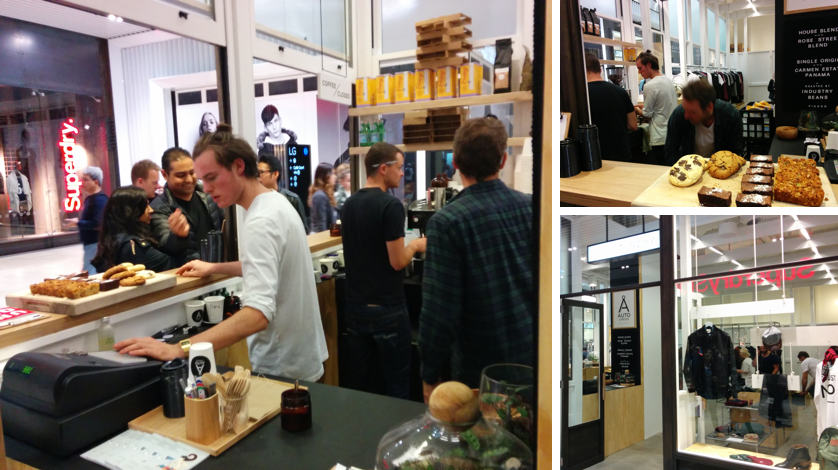
Lotions and Potions
Aesop went to great lengths to differentiate itself from other skin care product providers. Each of their retail units carry a distinct look and feel, this one in particular features strong use of woods and atmospheric lighting giving it almost the essence of climbing inside a sauna to experiment with their various skin products. What’s fascinating is their use of a row of lotion dispensers lining the exterior of the store and the accompanying video display to lure customers in. Don’t get me wrong, there’s nothing ground breaking about having samples placed out front of a store, but it was the palatable way in which it kindly beckons you into the store rather than the concept itself.
It’s amazing I could only come away with two interesting experiences to write on, both of which were of the individual retailers doing and not of the mall itself. Really, that’s it. And now that I’m done basically shitting on the Emporium Melbourne, I wish to offer more than criticism and look at what has evoked the response it has and what would be the learnings to apply to the next mall off the modern assembly line.
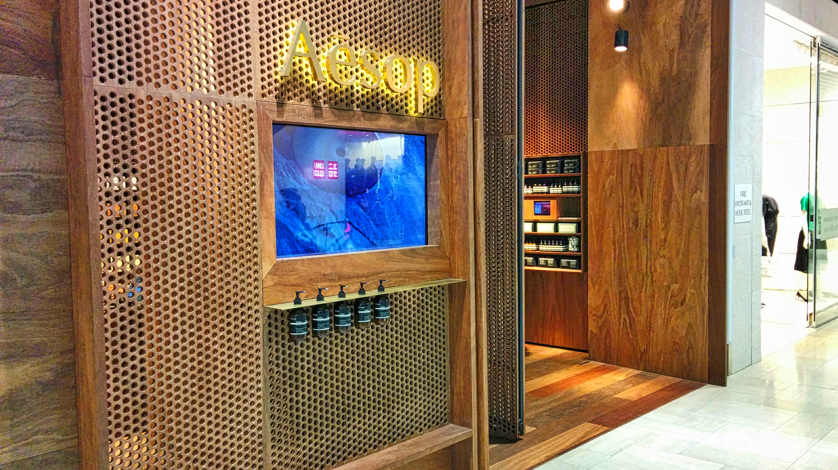
A Mall for Humans
Since we are talking about a luxury mall, and one that sits comfortably in the 10-digit build cost realm (entire airports and regional hospitals have been built for less), I think it’s within reason to suggest some unorthodox design concepts for a hypothetical mall that looks to overcome some of Emporium Melbourne’s shortcomings and disrupt the mall concept.
What I must admit is that construction of Emporium Melbourne would have been no easy feat. They would have contended with a gross number of engineering, safety, zoning and structural integration issues every step of the way during its planning and construction. So I’m not oblivious to these details.
What I’m proposing however, is that if we were to create a hypothetical free standing mall from the ground up, what would that look like? What elements would it have that speak more to basic human desires beyond a collection of brands selling goods behind glass windows. Let’s go through elements that I believe resolve the shortcomings of Emporium Melbourne, and where possible, provide examples of it’s successful execution.
Going Back To Our Roots
There’s a deeply rooted part of us that yearns for the feeling of the marketplaces and bazaars that our ancestors would have frequented in generations past. Some of you immediately conjure images of hot, sweaty, cramped, lacking in hygiene markets you’ve possibly stumbled onto in your travels in emerging or not so emerging markets. Yes, you’re wondering where I’m going with this. But you also cannot deny these markets are also perpetually bustling hives of activity and feel infinitely more real than any corridor of Emporium Melbourne or similar mall. Emerging markets still greatly depend on these markets to feed and clothe their populations, the modern malls are merely an illusion of how the common person lives.
Chiselled into us is thousands of years of gathering everything from playful trinkets to the very sustenance needed to live from such market places. What we’ve inherited is that wanting to be in a space that connects us as people for the common need to trade goods. Modern malls and their rows of high-end retailers are consequently unsatisfying to the soul. The very nature of their large glass shop fronts completely eliminates that tactile feel of goods being in hand’s reach. You may be dazzled by a Gucci store and it’s opulent surroundings, but that’s years of brand engineering overriding your more native self. The feeling you most likely feel if left to truly search yourself, is emptiness.
While I do not propose we bulldoze Emporium Melbourne and open a bazaar complete with tents and non-functional sewage, I am suggesting that we consider how the design of spaces caters to our inherited desire for communal energy. Spaces that have an element of constriction that cause interactivity with its occupants.
Merely blocks away in the more southern side of Melbourne’s CBD is the city’s true claim to fame, it’s laneways. They narrowly reside between tightly spaced buildings and are a people watcher’s wet dream. People politely negotiate the anttrail-like pedestrian traffic, cafe tables, sandwich boards and other random objects, because it feels human to do so. It reconnects us as people. There’s no such interaction between disassociated people in Emporium Melbourne because the space doesn’t invite it, nor even give the idea license.
What I suggest is intentional tightening of walking spaces, and creating greater variance in retailer sizes; creating zones of semi-warren-like areas. A trip to Akihabara, Tokyo, Japan gives you ample experiences of tall but narrow retail venues that may have many floors, but all tightly confined to a limited floor plate. Each floor is bustling with people exploring and experiencing the retail space. Taking this concept and appropriately applying it to districts within the hypothetical mall that draw people in such a manner, they then progress out to the more standardise shopping experience of larger more convention retail units. The human curiosity has been fed, and then lends to further exploration of a more standard experience.
Micro Retailing
The retailers in this marketplace format I speak of are naturally in the form of micro and temporary stores (typically nowadays over-referred to as “pop-up shops”). If executed well, the combination of transient and small single-proprietor stores satiate the need for us to connect at a more personal and direct level with the people responsible for the products we consume. You aren’t going to meet Ralph Lauren, but meeting the person that hand stitched your leather belt, or the one that invented the unique variety of ice cream treat you’re enjoying adds again to the human experience of shopping.
By varying the theme and having a continual supply of fresh micro businesses, a reason to regularly return to malls is created and gives opportunity for exposure to local small business owners. It helps to diversify what is otherwise a rather faceless collection of multinational and franchise stores seen in dozens or hundreds of other malls, and speaks to a youth generation that takes a greater interest in the origin of products. There’s plenty of examples how this concept has succeeded and failed. Where it failed can often be attributed to disingenuous intentions; questionable legitimacy that’s immediately apparent to consumers; lack of psychological understanding of the audience and disconnect from the very micro businesses it depends on. All solvable with the right curation.

Creating a Sense of Discovery and Belonging
Emporium Melbourne kind of flops it all out on the first date. I’m not wondering what’s around the next corner, I can guess with high certainty there’s another row of stores. Whether you’re a fan of the overpriced clothes they sell or not, a company like Abercrombie & Fitch knows how to create discovery. Even with relatively limited real estate space, they craft store experiences that invoke curiosity at every corner. A prime example of this is their flagship Singapore store along Orchard Road.
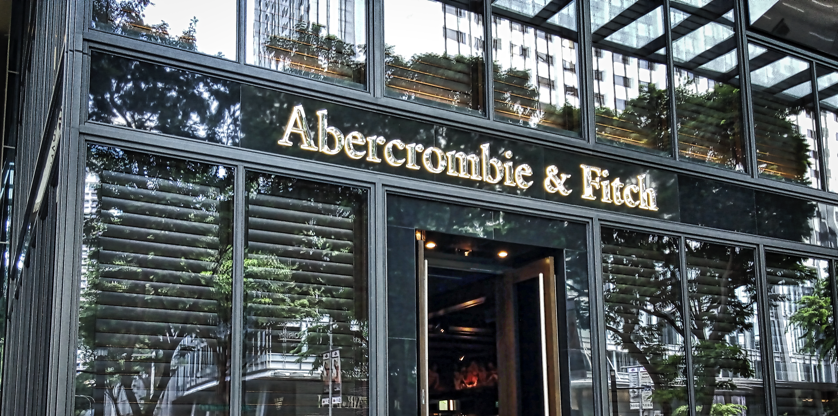
Entering through it’s front entrance is akin to being granted a bouncer’s blessing into a popular late night club. Pulsing music and a distinct youthful fragrance beckon you from within the store, pulling you down the foyer’s tall elongated hall ending in a wall that prompts you to turn into the store. It’s difficult to resist.
Upon turning into the store, you’re suddenly whisked away into a world of being part of something enviable, a club for ‘beautiful people’, merely by being present. As if you wouldn’t have arrived here if you weren’t ‘with it’. It’s nothing more than a retailer of branded polo shirts, jeans and the like, to well off teens (and often their parent’s money), but you feel part of much more.
It’s consumption gone wild, wrapped in an experience that masterfully ego strokes, addresses a yearning to belong, and satisfies one’s desire to discover. Frankly, when you distill it all down, it’s rather sad. A gold standard of manipulating our dreams, desires and insecurities, but it sure makes for a smashing case study to analyse.
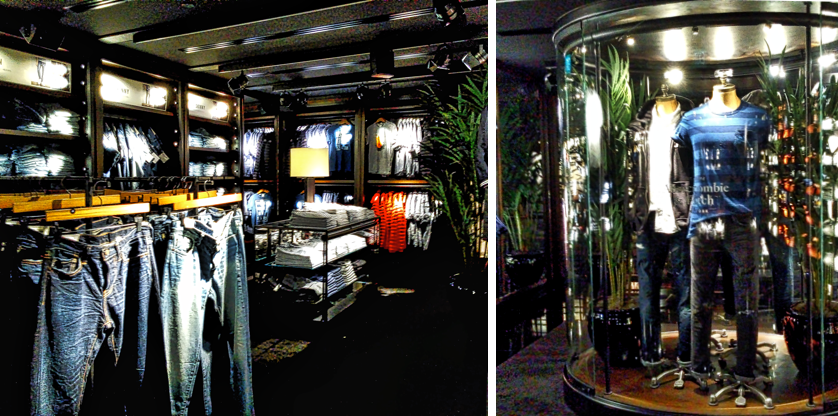
What creates this dream-like reality? Dimly lit rooms, punctuated by pronounced down lights strategically spotlighting products and design features. An obstacle course of clothes racks and showcases and elaborate floor plans send you off on an intriguing journey. Video walls featuring live feeds of surf beaches, artistic installations define the character and style of each distinct ‘district’ you encounter. Detailed wall murals, staircases, floor and ceiling treatments give it an authentic up scale nightclub-esq feeling. Quality is abundant… no detail has been overlooked, fixtures would have been obsessively selected and coordinated, sound system with clarity, strength, balance and tonal accuracy in even the seemingly most acoustically challenged corners. All-in-all it is the accumulative effect that has you feeling part of something substantive.
A more classic but still much relevant example of discoverability is IKEA. Most reading this article would have ventured through its winding retail experience in search of cheerful and modern home furnishings. It’s a combination of carefully architected floor plans, distinct zones featuring excellently executed displays recreating places in our lives to showcase their products, vibrant product displays and its overall welcoming hand waving you in to come look, touch, feel and interact that has millions coming back decade after decade.
Why can’t a mall have this similar sense of discovery? Why can’t it scrap the long never ending corridors of glass frontage stores and create depth, layers, textures, moods and a wanting to belong in its spaces?
Mingling of Unique Spaces
When mingling is done well, it’s really good. Some malls have gone from one extreme to another, such as when the Don Mills Centre indoor shopping mall in Toronto, Canada was nuked and transformed into Shoppes at Don Mills, a wholly outdoor experience. A rather bold move in a city where the temperature for half the year ranges from cold to below freezing. But then there’s malls such as Senayan City in Central Jakarta, Indonesia that is largely indoors, but then features a “crystal lagoon” that opens an entertainment area into open air from below grade. This infinite ceiling feeling, particularly in the evening hours is highly effective.
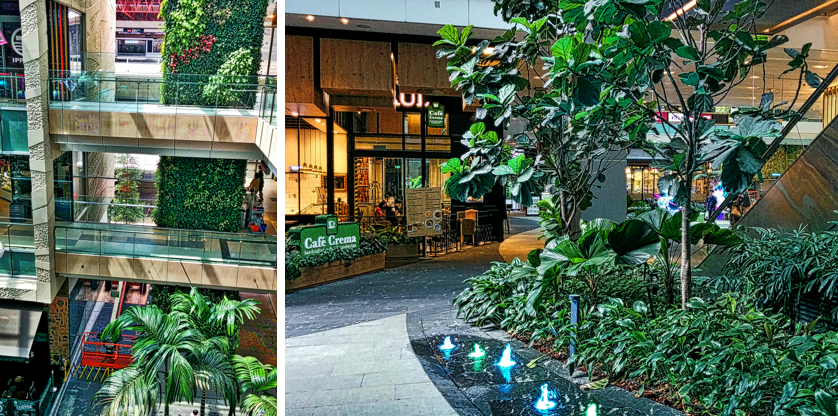
In temperate locations across the world, where climate is fairly predictable, it really becomes interesting when a mall can successfully mix and transition between in and out doors throughout the venue, adding depth and space to its environment. Westgate Mall Singapore, adjacent Jurong East MRT station does a commendable job of seamlessly transitioning between the out and in door zones, and giving glimpses of each space to each other. Use of green elements as a theme throughout the mall creates a beautiful sense of harmony between the outdoor and indoor zones.
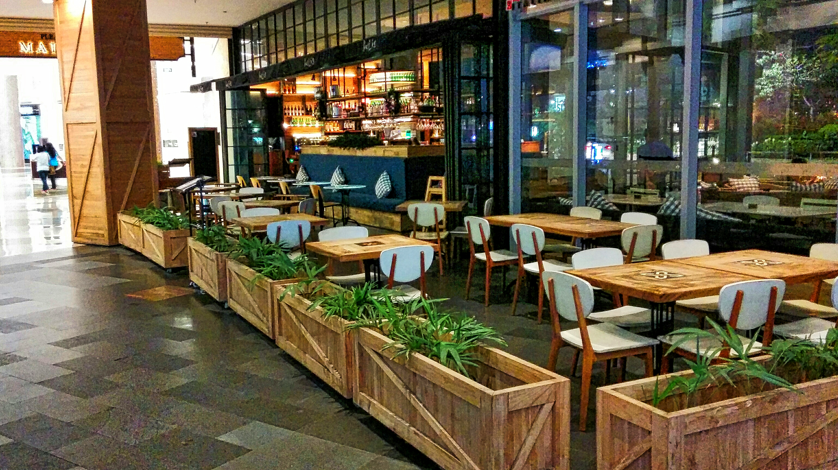
At a more micro level, mingling of retail and walkway spaces can further enhance the vibrance and liveliness of a space. Gandaria City Mall in Jakarta, Indonesia is a good example of how F&B retailers successfully integrate with walking spaces. Restaurant seating extending out into main corridors is both welcoming and lessens the sterile feel of glass enclosed retailers. It’s the fluidness of how one space openly interacts with another that counters the harsh detachment window displays create between its interior and onlookers. Ultimately changing onlookers into participants, because that’s what malls need to survive, participants.
Blending of spaces is what can create depth and complexity to a venue. Static and predictable spaces kill desire. A multi-floor store that boldly transcends floors as it juts out from walkways into a courtyard space can be infinitely more enticing to visit than a multi-floor store that simply exists on those floors connected by interior escalators. It leverages that multi-floor configuration and creates grand or prominent statements with that space.

And then there’s architecture. At the grand public opening of the National Gallery Singapore, I witnessed people in awe, captivated, snapping pictures… as they wandered through empty rooms. While there were numerous art installations throughout the venue, there were still many areas yet to be fitted with art, essentially just being rooms. But the combination of beautiful architecture and brilliant blending of old and new, had people absorbing the feeling of spaces, some clearly being moved emotionally by the experience. One could argue there was a sense of nationalism at play here, being a newly unveiled national masterpiece, but these emotions would not be stirred by merely adequate empty spaces – regardless of national pride. I too, with no stake in it’s existence, was most certainly moved by its architectural beauty.
In contrast, walking the corridors of Melbourne Emporium or St Moritz Lippo Mall in Jakarta (pictured in the article’s featured image) during their public soft launches was frankly, creepy. This shows the extraordinary impact architecture, variation and superior use of design have on the feel of a venue, regardless of what occupies it.
Well Defined Central Meeting Points
Lacking a meeting place within such a large venue is a sorely missed opportunity. If I told most Melbournian’s that I’d like to meet them under the clock at Melbourne Central, a mall only blocks away, they’d not only immediately know where I meant, but in fact be able to visualise and more importantly *feel* it in their minds. It’s beyond merely a circular promotional court in the middle of a mall, but something that has emotional connection for many. The hustle and bustle of hundreds of mostly student aged people on their mobile phones waiting for whomever they’re to meet is fascinating. It’s a place you can feel submersed into, it’s alive, dynamic. Emporium Melbourne on the other hand, I cannot think of such a place, that invokes any recall, emotion or recreation in my mind. The food court? No. That somewhat vaguely open-ish area next to the Nespresso boutique? No.
Melbourne Central’s “under the clock” meeting place consists of a large clock that animates and plays music on the hour throughout the day. People new to the venue can be spotted being either immediately mesmerised or fumbling with their camera to get a shot. It’s by no means a miraculous clock, but it somehow sets the right captivating presence for passerby.
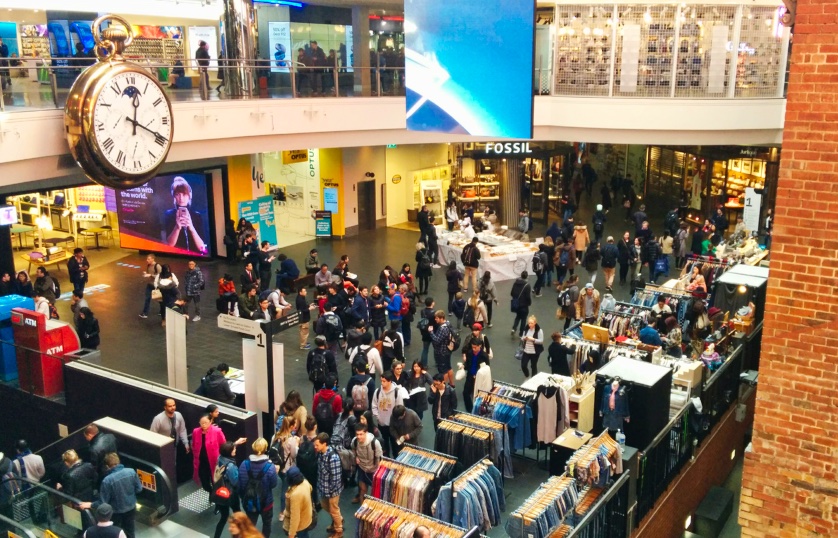
Beneath the clock, is an open walking area within an irregularly shaped space sandwiched between retail, an entire historic building enclosed within the mall, an escalator down to subways, and multiple paths leading into other retail corridors. In that irregular space is crammed a miniature market with small independent retailers selling fashionable goods, that does an exemplary job of offsetting the feel of mobile phone carrier stores immediately across from them that they themselves even acknowledge in their store design must conform to being beyond just a retail store. There’s just so much to absorb and look at in a single location, making it memorable and justified as a place one would wish to wait and meet others.
Humanising The Space
Toronto, Canada’s landmark Eatons Centre, with its famous flying geese that grace it’s high glass ceiling skies is an example of how simple installations of art have impact. Those geese have endured many decades and mall refurbishments because they’re symbolic of Canada. It’s a small but not overlooked element of the mall. If it was proposed they’d be taken down, you’d have people picketing in protest, I have no doubt about this. You’d hardly get that response if those same people were told one of the three Starbucks locations in that mall were to be closed. As the multi-story sized art installation at Kuningan City in Jakarta illustrates, art creates texture and drama to an otherwise soulless space.
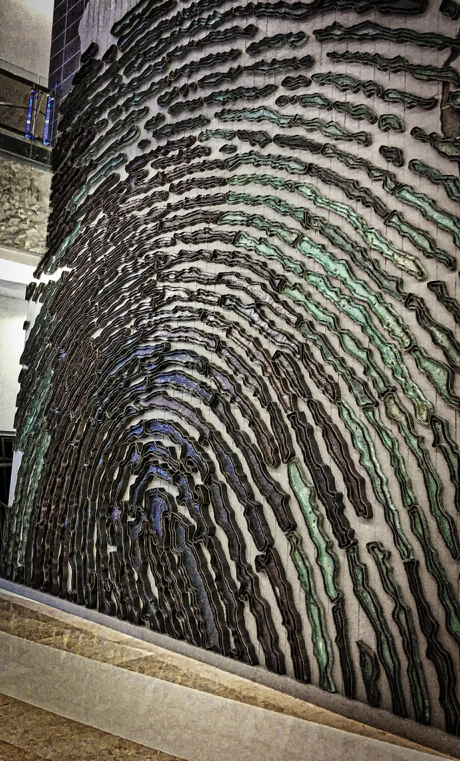
Combating Stereotypes
During a recent trip to Singapore, I sat waiting in the departures area of the magnificent Changi Airport for my return flight. Most public venues such as malls, hospitals and airports all have their fair share of negative stereotypes, terrible background music is often one of them.
Interestingly, as I sat waiting for my flight, my ears suddenly tuned into the background music playing over the airport sound system. To my amazement, it was a truly awkward Muzak rendition of Calvin Harris’ song “Summer”. Part of me squirmed in my seat at the almost unrecognisably butchered version of the club anthem, the other said, “Heck, at least it isn’t Kenny G”. It was a moment of knowing the airport was conscious of their music, and were trying to go in the right direction, but couldn’t quite go the distance for whatever reason (most likely gross public performance royalty fees).
Malls and elevators have forever battled each other for the terrible music throne. Playing weak Muzak versions of songs that even in their original forms were of questionable entertainment value to a contemporary audience. So when you have such a negative reputation, challenging it head on is often the only way to conquer it.
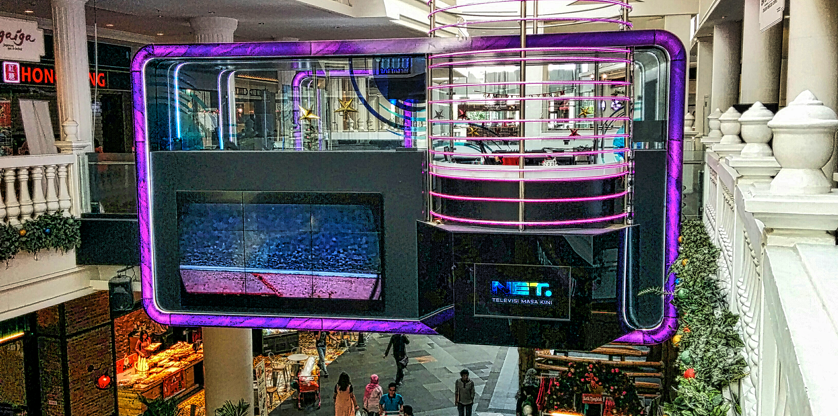
Perched on the second level, bridging two walkways in Gandaria City Mall in Jakarta is Indonesia’s first in-mall purpose-built DJ studio booth. Complete with all the telltale signs of a legitimate studio booth such as mics, shock-mounts, pop-filters, turntables and so forth. Named the “NetRadio Box” it plays contemporary hit music at set times midday and evening hours each day and Saturday nights hosts real DJ’s performing sets. This totally takes the stereotype and smashes it in the face. Which is what malls should be doing across the board for all their long held stereotypes. There’s no 20 year old that’s going clothes shopping at the mall, that would ever settle with Muzak… the constant digital inputs in their modern lives simply doesn’t give them the tolerance.
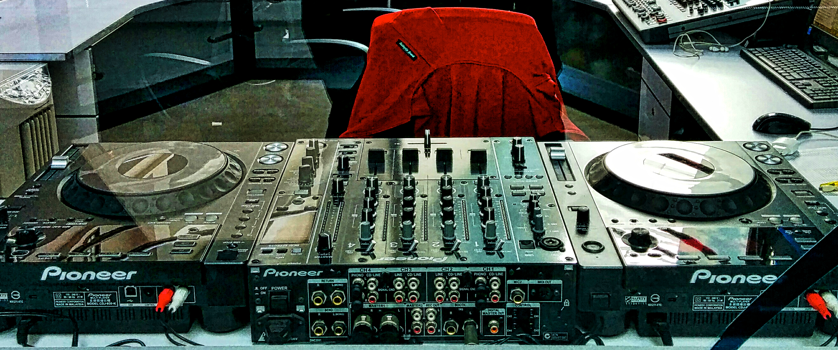
Takeaways
An interesting recent experience helps to illustrate the value and need of disruptive thinking in the world. I’d gone to meet a friend at a mall, and we’d agreed upon waiting in front of a particular store within the mall. After both of us had stood in front of the store for considerable time, exchanging messages and calls inquiring about each other’s whereabouts, we had come to the uneasy realisation that we were both in front of the same store, but in largely identical different malls on either sides of town.
While that felt like we’d visited some kind of parallel universe, it sadly points to a world devoid of disruptive thinking. It begs the question, “What would a mall look like if it was mandated from inception to disrupt the mall concept?” That every decision was to re-evaluate malls as a concept. What would have been the outcome with Emporium Melbourne? Most likely a substantially different experience.
There are even efforts in parts of the world to create entire identical cities and literally cookie-cutter them across the countryside. Mass producing replica cities conquers the inherent inefficiencies of organic creation, but how the citizens of these cities benefit is debatable.
Finally and most importantly, there’s a recurring theme throughout this article, a need to humanise the mall experience. While there’s been immense effort by retailers to understand human desires, the malls themselves are all too often soulless and lacking understanding of human desires. There’s clear examples as told throughout the article of cases where what could have been lifeless spaces have become inspiring and engaging spaces through careful consideration of what motivates us and speaks to our roots. When a mall costs $1.6bn to create, it can’t afford not to stick it’s head out and change the formula.

